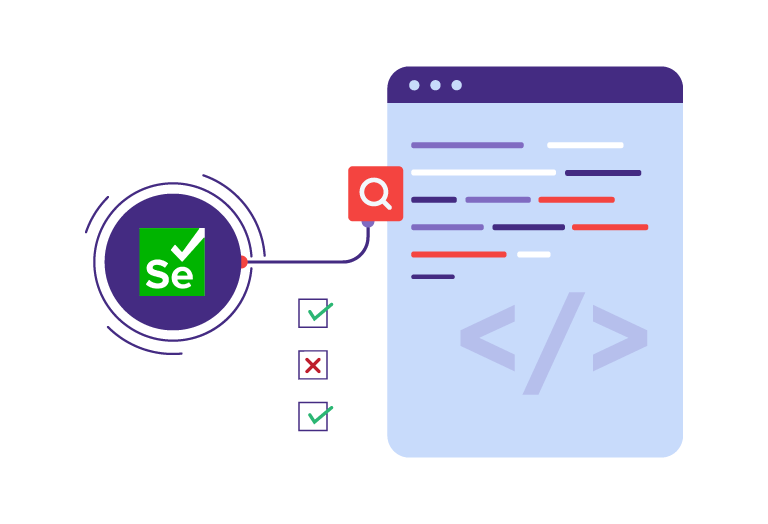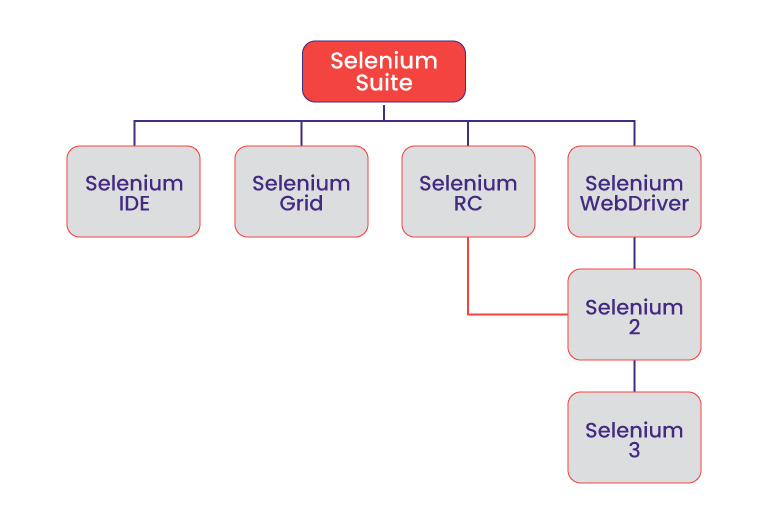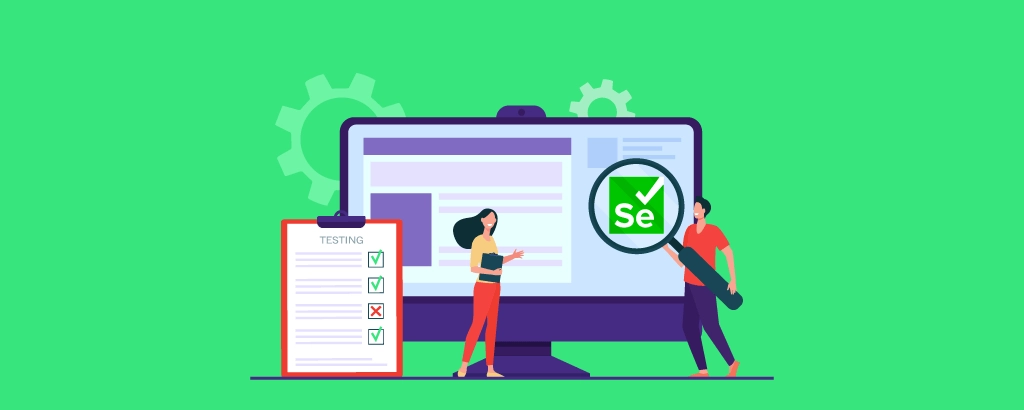Look into the intelligent Automation Testing Suite – The Selenium
Here’s some food for thought. A common saying goes this way “ Failing to plan is planning to fail” This makes so much sense in everyday life and even better when it comes to web development. What looks easygoing from the outside can seem like a real roller coaster ride from within. So, Planning is key! Organizations can no longer follow the “set it and forget it strategy” for web development while setting up an online business image for branding campaigns and marketing. While it’s great if you have a web app with a classic design but unless you test the loading speed, navigation controls, and other elements that make it perform better, your web development efforts do not complete the full circle. Oh, Wait! Did I say testing the web application? Testing that helps you fix bugs and overcome sudden spikes in web traffic? How about browser testing with the automation testing tool- Selenium?
Selenium: The Name and Fame
Heeding to the common definition, Selenium is a free open source testing suite that is used widely for software quality assurance or more precisely to AUTOMATE testing of web applications. I repeat, web application and not any desktop software application or mobile application. Although this might set your spirits low, it’s important to note that when it comes to dynamic web app testing you won’t find anyone better than the Selenium framework. But have you wondered why an automation testing tool is named after a chemical component with atomic number 36? There’s an interesting story behind it. A popular testing framework by the company Mercury Interactive was on the go during the development of Selenium. As Selenium, in the chemical world is known for Mercury poisoning, its developers agreed  Selenium as the most befitting name. Numerous factors have led Selenium to walk abreast of other technologies in the software testing world, the number one being its Automation ability. Way before Selenium came into the scene, software testing took countless hours with manual testers enacting and reenacting codes to the microscopic level figuring out errors, the source of the breakages, and waving them off. Now, there comes Selenium to bridge the gap between the running days and testing efforts. What more can you ask for, if an Automation testing tool optimizes the security, stability, and performance within a short time frame with nearly instant feedback? Moreover, Selenium testing tool give developers the liberty to create test scripts in any preferred programming language. You need not pool in your time mastering a specific program that the Selenium framework supports. Be it C#, Java, Ruby, PHP, Node.js, Python, or Perl, the single interface of Selenium Web Automation will execute these scripts in the browser interface of your device. Is that all? No! Hold your horses, since there are more advantages to Selenium covered in this blog extending further down. But how do you get there without unlocking the Selenium Automation Tools Suite? The fact that Selenium works under automation is what makes it the best catch in the market today.
Selenium as the most befitting name. Numerous factors have led Selenium to walk abreast of other technologies in the software testing world, the number one being its Automation ability. Way before Selenium came into the scene, software testing took countless hours with manual testers enacting and reenacting codes to the microscopic level figuring out errors, the source of the breakages, and waving them off. Now, there comes Selenium to bridge the gap between the running days and testing efforts. What more can you ask for, if an Automation testing tool optimizes the security, stability, and performance within a short time frame with nearly instant feedback? Moreover, Selenium testing tool give developers the liberty to create test scripts in any preferred programming language. You need not pool in your time mastering a specific program that the Selenium framework supports. Be it C#, Java, Ruby, PHP, Node.js, Python, or Perl, the single interface of Selenium Web Automation will execute these scripts in the browser interface of your device. Is that all? No! Hold your horses, since there are more advantages to Selenium covered in this blog extending further down. But how do you get there without unlocking the Selenium Automation Tools Suite? The fact that Selenium works under automation is what makes it the best catch in the market today.
Selenium Unveiled: Navigating the Thriving World of Automated Testing Tools
When I say Selenium Web Automation, you need to think of it in the bigger picture. Something that resembles a toolbox with many different tools in it. In that sense, the Selenium tool kit/tool suite consists of four frameworks with individual purposes. If you are a software tester slogging with errors, mistakes causing fatigue, and boredom, all you need is to own this diverse toolkit. Then your days of faster testing are not far behind.
- Selenium Integrated Development Environment (IDE)
- Selenium Web Driver
- Selenium Remote Control
- Selenium Grid
Let’s see how these components work.
Selenium Integrated Development Environment (IDE)
Long ago, Selenium IDE was known as Selenium Recorder but with time it saw a shift in the name just as in its function. One of the simplest frameworks in the Selenium testing tool, IDE is a Firefox plugin that helps record and execute test cases quickly. But how are these test cases created? It’s done by taking a measure of user interaction with the web browser. Once they are recorded they can be played several times as per the requirement. But you need to keep in mind that it’s a prototyping tool that only creates simple test cases, so you need to figure out another framework in case you are working with dynamic web applications.
Selenium Remote Control (RC)
Before we dive into the particulars of Selenium Remote Control, let’s understand what it was made for. Before Selenium RC, in the version called Selenium core a “same-origin policy” was strongly under work. This simply means that Java Code was not allowed to access web elements from other domains than its own. However, with Selenium RC, this major roadblock was settled. RC the problem-solver now tricks the web browser into believing that both Selenium Core and the web app originated from the same parent domains. For this, RC relies on an HTTP proxy server that divides it into two components – Selenium RC Server and Selenium RC Client. Along with these achievements, RC also holds the credit as a flagship testing framework liberating users from programming language constraints.
Selenium WebDriver
The Quality Assurance folks said hello to Cross Browser testing for the first time with Selenium WebDriver. Firstly, if you place Web Driver and IDE on the same plane, you will notice that Web Driver gives you an interface to create and execute test cases. Unlike IDE, test cases are set up by directly communicating with the browser. The Next noted fact about the Selenium WebDriver is its integration with RC in 2008 giving birth to an upgraded version of an automation testing tool called Selenium 2. This gave rise to a contemporary yet stable approach in the automation arena.
Selenium Grid
Selenium Grid runs along with Selenium RC to reduce the number of times test cases are executed. It was specifically used to perform testing on Remote machines. Grid is versatile in running parallel test cases at a time in different machines. At the same time, the Selenium grid makes use of a Hub-Node design. In this concept, one machine is seen as the Hub sending Selenium commands and other connected machines are Nodes on which test cases are written.
Tracing the Selenium Timeline
As we now know that the Selenium Automation Testing Framework is a family of four, how about taking a closer look at the back story of each framework? It all began with a single man from a single company in Chicago, in 2004. Jason Huggins from ThoughtWorks fell on a keen interest in developing a testing framework for a Time and Expenses application that he had built. It was called the core mode of Selenium with the name “JavaScriptTestRunner”. Jason’s automation testing tool soon expanded across his circle of colleagues winning immediate appreciation. Several of his fellow ThoughtWorkers joined him in setting up Selenium’s foundation for drivers in yet more programming languages. One of his co-workers, Paul Hammant suggests the  possibility of a ‘server’ component so that the JavaScript injection could be removed which led to the complete development of the Selenium Automation framework. Popular demand caused them to open-source the tool widely. Selenium soon became part of many ThoughtWorks projects across the world with every project bringing in a new change to the framework. In 2005, likewise marks the birth of Selenium Remote Control when in Bea, two men named Dan Fabulich and Nelson Sproul worked on the server code to develop an even better standalone that bundled MortBay’s Jetty as the web proxy. With time, Selenium testing crossed the oceans in 2006 to Japan where Shinya Kasatani tried to tie the core code around into an IDE module and integrate it into the Firefox browser. Hence, the birth of Selenium IDE allowed for live testing on a website. Meanwhile, back at ThoughtWorks in 2007, Simon Stewart was working on a different testing tool with higher API than Selenium RC separate for each browser that was coded from scratch and there goes our Selenium Web Driver. Further, the very next year in 2008 Patrick Lightbody at ThoughtWorks created Selenium Grid. It allowed Browser instances to run and test from multiple remote devices. Developments were quick in Selenium architecture year after year and to date, it is known for its simplicity and availability.
possibility of a ‘server’ component so that the JavaScript injection could be removed which led to the complete development of the Selenium Automation framework. Popular demand caused them to open-source the tool widely. Selenium soon became part of many ThoughtWorks projects across the world with every project bringing in a new change to the framework. In 2005, likewise marks the birth of Selenium Remote Control when in Bea, two men named Dan Fabulich and Nelson Sproul worked on the server code to develop an even better standalone that bundled MortBay’s Jetty as the web proxy. With time, Selenium testing crossed the oceans in 2006 to Japan where Shinya Kasatani tried to tie the core code around into an IDE module and integrate it into the Firefox browser. Hence, the birth of Selenium IDE allowed for live testing on a website. Meanwhile, back at ThoughtWorks in 2007, Simon Stewart was working on a different testing tool with higher API than Selenium RC separate for each browser that was coded from scratch and there goes our Selenium Web Driver. Further, the very next year in 2008 Patrick Lightbody at ThoughtWorks created Selenium Grid. It allowed Browser instances to run and test from multiple remote devices. Developments were quick in Selenium architecture year after year and to date, it is known for its simplicity and availability.
Let’s Talk about 4 major Selenium Promises
Selenium is in every sense the Automation King! As Testing and validation of your web apps cannot be compromised you need some strong facts to choose Selenium as your testing companion. It’s a long list that includes – Reusability, Flexibility, constant updation, minimal hardware usage, and more. But Here they are, the top 4 facts and promises that made Selenium what it is today.
Promise 1: Open Source
Are there any better reasons to not choose Selenium testing? It’s Open Source with public accessibility of the framework made available. No matter the size of your business, with Selenium you cut down licensing and upfront costs to a great extent. Being open-source also implies greater customizability towards better codes.
Promise 2: Learner Friendly and Easy use
You can gather all your time and effort for other causes! The Selenium automation testing tool bids goodbye to running pages of algorithms and codes. For instance, Selenium ID is designed with HTML features – the basics. Once done, you can move on to refer to sophisticated documents to learn the tools in complete depth. Companies investing in Selenium also win the advantage of not having to train their developers. Just in case they wish to, a plethora of Selenium tutorials is just a search away on the Internet.
Promise 3: Supports Multiple Browsers, OS and Programming Languages
You do not want to keep switching from one testing tool to another that fits different kinds of browser or operating system requirements. Selenium testing plays well with a wide range of web browsers like Firefox, Internet Explorer, Chrome, Safari, and Opera. What’s more, it also goes well with Apple OS, Linux, and Microsoft Windows. Finally, as I mentioned earlier up it deals with all major programming languages – Java, C#, Perl, Ruby, JavaScript, etc.
Promise 4: Quicker Debugging
Debugging gets done within a matter of minutes with Selenium. The status of your debugging is displayed in the form of a report below the test screen. Testers can immediately detect where things are going wrong with the highlighted parts in the report. Now, if you wish to combine Selenium with other debugging tools, you can move ahead with that idea.
5 Types of Testing Automated with Selenium
Let’s take a sneak peek into each of the six tests possible with the Selenium automation hybrid framework.
- Performance Testing: The name has it all. Selenium tests the performance of web applications to make sure it meets certain benchmarks. TestScript keeps an eye on two kinds of performance under load and stress. Load performance is measured by checking how well a website functions, say when a large number of users are accessing it at one go. Stress performance is another marker that tells if a website is able to handle beyond the maximum supported load.
- Compatibility Testing: A form of testing done to ensure that your application is equally compatible with all different kinds of browsers. Only this can ensure that more people can access and use it across all popular browsers. Your advanced Selenium testing for web applications will show you if there are page alignment issues, font size mismatch, Image disorientation, inaccuracy in video ad rendering, browser incompatibility with OS, and so on.
- Regression Testing: When a code change is made, you do not want it to disrupt the existing features. In regression testing, already executed test cases are re-executed once again with the newly built features to ensure that doesn’t break the pre-written checkout feature. Selenium testing tools run automated regression to check if modifications have caused the system to work incorrectly.
- Functional Testing: Every web app is defined by the boundaries of the business environment. So, keeping a constant eye on whether or not it meets their requirements is of utmost importance. In times like these, Selenium Automation Testing surfs through the UI layer of the web application to check if the graphic content including buttons, menus, and check box options are all displayed correctly. It runs smoke tests occasionally to see if the app works well on a general scale with its mainline functions. Also, grade accessibility and its basic usability.
- End-to-End Testing: Developers prefer Automation testing tools when it comes to end testing as they can easily get rid of the cloud servers and other complicated infrastructure. And it’s even more rewarding with Selenium as it offers a communication channel using API so that the web browser interacts with the DOM.
The Enchanting Realm of Selenium
There’s no doubt that the Selenium Automation Framework is winning millions of hearts with all of its advantages. Since Selenium can automate all the testing tasks just as well as a real person, it has occupied a major space across industries. My breath catches at the thought that Selenium has replaced manual testing in 47,000+ companies globally. Popular names also fall in this list including Mozilla, Google, Linkedin, and companies like Accenture, Trivago, Bitpanda, and more. Don’t think of it as only working for the computer software industry, because Advanced Selenium Testing for web Applications has flowed into Healthcare, Telecommunication, Retail, Insurance, and Education Management successfully. The United States by far remains the top-ranked country with Selenium customers followed by the United Kingdom and India. All these statistics indicate the sweeping popularity of Selenium in the coming years too.
Maybe it was true when Federico Toledo said “ Test less but Test smarter”
Selenium Automation Support with Pattem Digital
Are you also looking to join automation with CMS development Services? Then we perceive that you understand the deep logic of setting excellent user interfaces and functionalities. Pattem Digital can give your business an accessible face through our Selenium Automation Hybrid Framework. As a Selenium Testing company supporting major brands in the frontline, we are backed by a certified team of Selenium experts to deliver your needs with flexibility and reliability. Contact us to know how we can help you!


